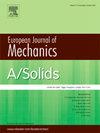基于仿真的不同载荷条件下4R法疲劳评估
IF 4.4
2区 工程技术
Q1 MECHANICS
引用次数: 0
摘要
本研究探讨了基于模拟的疲劳评估模型的使用,该模型结合了计算焊接力学(CWM)和力学分析来获得局部疲劳有效应力。应用的CWM分析包括顺序耦合热源建模和力学分析,以预测局部材料性能、残余应力和焊接变形。随后,考虑不同载荷条件、焊接残余应力和热影响区(HAZ)预估材料状态变化,基于材料循环模拟进行疲劳评估。目前的工作评估了纵向扣板节点在不同载荷条件下的疲劳强度:恒幅、变幅和准静态超载恒幅载荷。采用多参数疲劳评估方法(4R法)进行计算疲劳评估,并通过疲劳试验对计算结果进行了验证。模拟的焊接残余应力和热影响区材料性能与实验结果吻合较好。此外,拟合试验疲劳数据和模拟应力结果的S-N主曲线在不同载荷条件下具有较小的散射范围指数,为Tσ,sim = 1.25。模型对预估材料性能的敏感性研究表明,循环强度系数是疲劳寿命预估中影响最大的因素。本文章由计算机程序翻译,如有差异,请以英文原文为准。
Simulation-based fatigue assessment using the 4R method in different load conditions
This study examines the use of simulation-based model for the fatigue assessment that combines computational weld mechanics (CWM) and mechanical analysis to obtain local fatigue-effective stresses. The applied CWM analysis includes sequentially coupled heat source modeling and mechanical analysis to predict local material properties, residual stresses, and welding deformations. Subsequentially, fatigue assessments are conducted based on the material cyclic simulations considering different load conditions, welding-induced residual stresses and estimated material condition changes at the heat-affected zone (HAZ). The current work evaluates the fatigue strength of a longitudinal gusset joint subjected to different load conditions: constant amplitude, variable amplitude, and quasi-statically overloaded constant amplitude loads. The computational fatigue assessments are performed using a multiparametric fatigue assessment approach, namely the 4R method, and computational results are verified with the experimental fatigue tests. The simulated welding-induced residual stresses and material properties at the HAZ showed reasonable agreement with the experimental results. In addition, the S–N master curve fitted to the experimental fatigue data and simulation stress results shows a relatively small scatter range index, equal to Tσ,sim = 1.25 considering different load conditions. The model sensitivity study to the estimated material properties showed that the cyclic strength coefficient is the most influential factor in fatigue life estimation.
求助全文
通过发布文献求助,成功后即可免费获取论文全文。
去求助
来源期刊
CiteScore
7.00
自引率
7.30%
发文量
275
审稿时长
48 days
期刊介绍:
The European Journal of Mechanics endash; A/Solids continues to publish articles in English in all areas of Solid Mechanics from the physical and mathematical basis to materials engineering, technological applications and methods of modern computational mechanics, both pure and applied research.

 求助内容:
求助内容: 应助结果提醒方式:
应助结果提醒方式:


